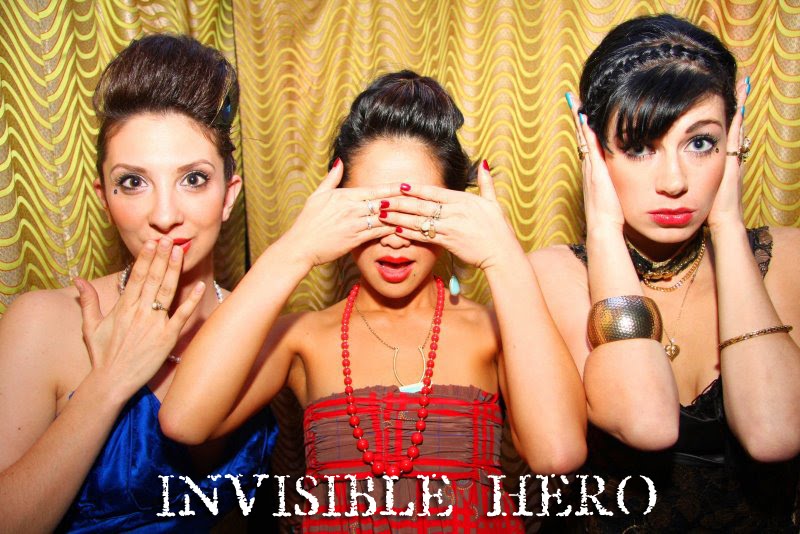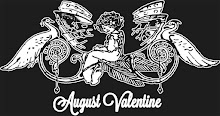If Thursday is the new Friday, then Harlot has got you covered. With its new mid-week monthly, Night Vision-- the third Thursday of every month--Harlot promises heavy house with enough audio-visual stimulation to keep even the most pampered partiers well entertained.
This month’s Night Vision treated attendees to a fashion show by two of San Francisco’s freshest and eco-friendliest designers, Charlie Fischer of Invisible Hero Industries and Amy M. Ho. As a platoon of diverse models took to the catwalk, sporting grass-covered welding masks and fur trooper hats, a theme of the inventive opportunities of re-use fashion came to mind. “I would like to see eco-fashion be more fashionable,” said Invisible Hero Industries’ Charlie Fischer, following a parade of her newest collection which included re-used leather, silk, cotton, and synthetics cut to create thigh-high evening slips and cropped denim-look onesies with larger-than-life bows.
Both Fischer and Ho represent a movement that is growing in the fashion world on at least a local level with rapid celebrity: sustainable fashion design with roots outside the fashion industry. In many cases, this equates to designers who are self-taught or academically trained in a related field (including fields as varied as textile design, fine art, and theatre design). This sort of diversity allows designers to think outside of the constraints and assumptions of the fashion industry, resulting in innovative designs and factory-free construction, produced and promoted on a local level. In the case of Fischer and Ho, the concept is obviously working.
Charlie Fischer’s introduction to the world of fashion began when she was only four years old. Sewing lessons from mom led to an interest in fashion design with roots in construction. This attention to manufacture would later blossom into Invisible Hero Industries, an independent label with an emphasis on sustainability. Fischer’s work resists the repetition of prints and cuts seen in traditional ready to wear collections. Instead, designs are based on the fabrics themselves, allowing Fischer to create a selection of one-of-a-kind, detail-oriented articles as creative as they are diverse. Select articles are available in stores throughout San Francisco including Artillery Gallery, Loft 1513, Tribus Vivas, and Trunk in the Haight.
Amy M. Ho’s work also represents an inventive, if not outrageous, break with the fashion industry. Ho’s background is academic, but also unorthodox when speaking of the traditional industry-based education most designers are expected to have. With an MFA focused in Installation Art from Mills College on the horizon, and designers Do Ho Suh and Yayoi Kusama operating as her inspiration, Ho says she is less concerned about making ready to wear items and more interested in exploring the possibilities of three-dimensional, wearable shapes. The result is Ho’s second collection, a complicated and intriguing landscape of re-used satin, cotton, and velveteen fabrics twisted, warped, and wired to form dresses with bouncy, upturned, star-shaped hems, whirling tentacles, and clusters of multi-colored, protruding cones. The collection is as worthy of a museum as it is a cat walk and speaks to the imaginative possibilities of art-based fashion while still averting the economic concerns facing couture.
Harlot’s newest monthly addition is the vision of San Francisco party kid turned organizer Nick Santoro of NS Presents. Santoro, a veteran of SF’s music and art scenes, got his first taste of the complicated world of party promotion when he was offered to curate shows at SF State. He wanted to continue to independently produce parties that merged the world of music and art and soon generated a certain amount of underground renown through parties held at his loft in the Inner Richmond. It wasn’t long before bigger, more legit venues were knocking at his door. As both a DJ and organizer, Santoro is as much a part of the music scene as a promoter, having held residencies at Mezzanine, Mighty, Vessel, and the Rickshaw Stop. With Night Vision, Santoro hopes to keep the intersection of San Francisco’s art and music scenes well at large by incorporating fashion designers, dancers, and visual artists to create a welcoming party atmosphere that offers something for everyone.
It’s no surprise that an aesthetically-driven night like Night Vision should find its home at Harlot, a club where dedication to details is what gives the space its special edge. A modest dance floor glowing rouge under a luminescent backdrop and ample seating equip with cowhide regency couches and snake-skin booths, seamlessly accommodate both relaxation and recklessness. Large-scale reproductions of classical paintings framed by heavy velveteen drapery in devilish shades of red and black create a steamy but chic bordello atmosphere while reappropriated wine bottle light fixtures, entwined antler chandeliers, and twisting tree limbs scouring the walls give the room a surprisingly organic feel. For those daring to venture out solo, a smoking cage overlooking the Minna St. alley makes an excellent spot to mingle with your fellow addicts.
With the next Night Vision starting to come into view for 2010, Santoro promises that more fashion and more art are on the horizon. You can keep posted on Night Vision’s upcoming agenda via Harlot’s websites, or by visiting the NS Presents blog.
Big thank yous to those who helped make this happen.
Wednesday, December 30, 2009
Invisible Hero Examiner Write up...
Labels:
Eco Fashion,
Examiner,
Invisible Hero Press,
San Francsico
Subscribe to:
Post Comments (Atom)





No comments:
Post a Comment